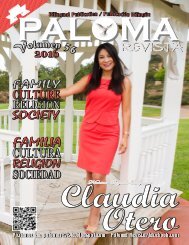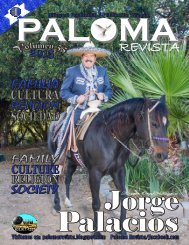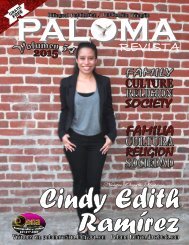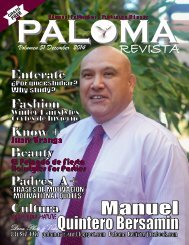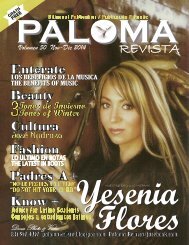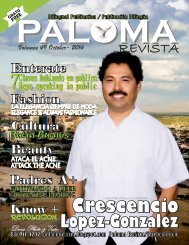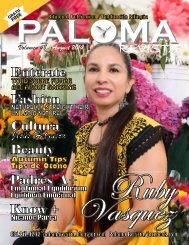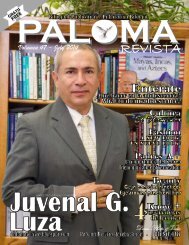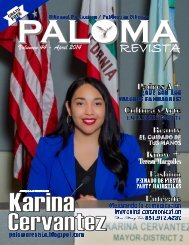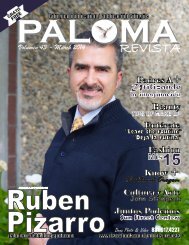Paloma Magazine Volume 46
Paloma is a nonprofit Magazine for the entire family. We intend to educate and inform the community with positive messages and themes. We are also a media communication that offers publicity to the community. In Paloma Magazine by advertising your business, you get more than advertising because this magazine brings valuable and useful information with a positive message to households. In every issue we bring together and promote, culture, family, religion.
Paloma is a nonprofit Magazine for the entire family. We intend to educate and inform the community with positive messages and themes. We are also a media communication that offers publicity to the community. In Paloma Magazine by advertising your business, you get more than advertising because this magazine brings valuable and useful information with a positive message to households. In every issue we bring together and promote, culture, family, religion.
You also want an ePaper? Increase the reach of your titles
YUMPU automatically turns print PDFs into web optimized ePapers that Google loves.
¿SABIAS QUE?<br />
Sabias que, hasta el siglo XIX se escribía con<br />
plumas de pato y ganso. Los patos tienen seis<br />
párpados, tres en cada ojo. Durante el tiempo<br />
que tarda un pato en mudar las plumas, no<br />
puede volar. Todos los patos tienen plumas<br />
impermeables. Lo son tanto que incluso<br />
cuando se meten bajo el agua las capas<br />
inferiores permanecen secas. Al construir<br />
su nido, el pato usa su plumón suave que<br />
se arranca. Esto le da a los huevos la mejor<br />
amortiguación posible el aislamiento.<br />
Muy pocos machos hacen “cuac:.<br />
En cambio sus llamadas pueden incluir<br />
chillidos, gruñidos, gemidos, chirridos,<br />
silbidos, rebuznos y gruñidos. Hay más de<br />
40 razas de pato doméstico. El pato Pekin<br />
blanco (también llamado el pato Long Island)<br />
es la variedad más común.Durante mucho<br />
tiempo se creyó que el sonido que provocan<br />
los patos, llamado graznido, era un sonido<br />
que no producía eco. Los científicos de la<br />
universidad de Salford en Inglaterra,<br />
demostraron que si había eco producid por<br />
ese sonido. El eco consiste en una señal<br />
acústica original que se extingue y<br />
escuchamos su onda, su reflejo sobre<br />
algún obstáculo como una nueva señal.<br />
La distancia mínima para que<br />
se produzca el eco es de 17m.<br />
Did you know that until the nineteenth<br />
century we wrote with goose and duck<br />
feathers. Ducks have six eyelids, three in<br />
each eye. During the time it takes a duck<br />
molt, they can not fly. All ducks have<br />
waterproof feathers. So much that even when<br />
they get under water the lower layers remain<br />
dry. When building its nest, they use their soft<br />
feather that they rip off. This gives the eggs<br />
the best possible damping isolation.Very few<br />
males do "quack". Instead calls may include<br />
screams, grunts, groans, squeaks, whistles,<br />
grunts and brays. There are over 40 breeds of<br />
domestic ducks. The white Pekin duck ( also<br />
called the Long Island duck ) is the variety<br />
most common.Over the long time it was<br />
believed that the sound causing the ducks<br />
quacking call was a sound that did not<br />
produce an echo. Scientists from the<br />
University of Salford in England, proved that<br />
there is an echo from the sound. The echo is<br />
an acoustic signal that is extinguished and<br />
Heard by its wave, reflected on an obstacle<br />
as a new signal. The minimum distance<br />
for the echo to occur is 17m .<br />
87 PALOMA REVISTA (831) 917- 4227 “AHORA...TODOS PUEDEN ANUNCIARSE’




